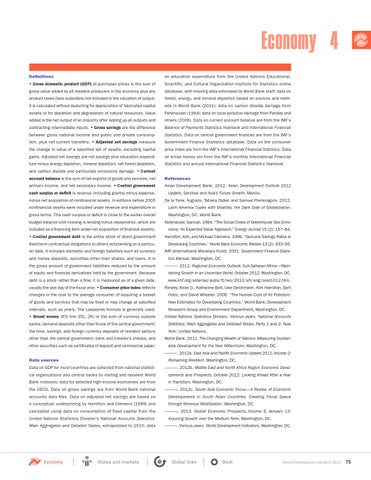Economy 4 Definitions
on education expenditure from the United Nations Educational,
• Gross domestic product (GDP) at purchaser prices is the sum of
Scientific, and Cultural Organization Institute for Statistics online
gross value added by all resident producers in the economy plus any
database, with missing data estimated by World Bank staff; data on
product taxes (less subsidies) not included in the valuation of output.
forest, energy, and mineral depletion based on sources and meth-
It is calculated without deducting for depreciation of fabricated capital
ods in World Bank (2011); data on carbon dioxide damage from
assets or for depletion and degradation of natural resources. Value
Fankhauser (1994); data on local pollution damage from Pandey and
added is the net output of an industry after adding up all outputs and
others (2006). Data on current account balance are from the IMF’s
subtracting intermediate inputs. • Gross savings are the difference
Balance of Payments Statistics Yearbook and International Financial
between gross national income and public and private consump-
Statistics. Data on central government finances are from the IMF’s
tion, plus net current transfers. • Adjusted net savings measure
Government Finance Statistics database. Data on the consumer
the change in value of a specified set of assets, excluding capital
price index are from the IMF’s International Financial Statistics. Data
gains. Adjusted net savings are net savings plus education expendi-
on broad money are from the IMF’s monthly International Financial
ture minus energy depletion, mineral depletion, net forest depletion,
Statistics and annual International Financial Statistics Yearbook.
and carbon dioxide and particulate emissions damage. • Current account balance is the sum of net exports of goods and services, net
References
primary income, and net secondary income. • Central government
Asian Development Bank. 2012. Asian Development Outlook 2012
cash surplus or deficit is revenue (including grants) minus expense,
Update: Services and Asia’s Future Growth. Manila.
minus net acquisition of nonfinancial assets. In editions before 2005
De la Torre, Augusto, Tatiana Didier, and Samuel Pienknagura. 2012.
nonfinancial assets were included under revenue and expenditure in
Latin America Copes with Volatility, the Dark Side of Globalization.
gross terms. This cash surplus or deficit is close to the earlier overall budget balance (still missing is lending minus repayments, which are
Washington, DC: World Bank. Fankhauser, Samuel. 1994. “The Social Costs of Greenhouse Gas Emis-
included as a financing item under net acquisition of financial assets).
sions: An Expected Value Approach.” Energy Journal 15 (2): 157–84.
• Central government debt is the entire stock of direct government
Hamilton, Kirk, and Michael Clemens. 1999. “Genuine Savings Rates in
fixed-term contractual obligations to others outstanding on a particu-
Developing Countries.” World Bank Economic Review 13 (2): 333–56.
lar date. It includes domestic and foreign liabilities such as currency
IMF (International Monetary Fund). 2001. Government Finance Statis-
and money deposits, securities other than shares, and loans. It is
tics Manual. Washington, DC.
the gross amount of government liabilities reduced by the amount
———. 2012. Regional Economic Outlook: Sub-Saharan Africa—Main-
of equity and financial derivatives held by the government. Because
taining Growth in an Uncertain World, October 2012. Washington, DC.
debt is a stock rather than a flow, it is measured as of a given date,
www.imf.org/external/pubs/ft/reo/2012/afr/eng/sreo1012.htm.
usually the last day of the fiscal year. • Consumer price index reflects
Pandey, Kiran D., Katharine Bolt, Uwe Deichmann, Kirk Hamilton, Bart
changes in the cost to the average consumer of acquiring a basket
Ostro, and David Wheeler. 2006. “The Human Cost of Air Pollution:
of goods and services that may be fixed or may change at specified
New Estimates for Developing Countries.” World Bank, Development
intervals, such as yearly. The Laspeyres formula is generally used.
Research Group and Environment Department, Washington, DC.
• Broad money (IFS line 35L..ZK) is the sum of currency outside
United Nations Statistics Division. Various years. National Accounts
banks; demand deposits other than those of the central government;
Statistics: Main Aggregates and Detailed Tables. Parts 1 and 2. New
the time, savings, and foreign currency deposits of resident sectors other than the central government; bank and traveler’s checks; and other securities such as certificates of deposit and commercial paper.
York: United Nations. World Bank. 2011. The Changing Wealth of Nations: Measuring Sustainable Development for the New Millennium. Washington, DC. ———. 2012a. East Asia and Pacific Economic Update 2012, Volume 2:
Data sources
Remaining Resilient. Washington, DC.
Data on GDP for most countries are collected from national statisti-
———. 2012b. Middle East and North Africa Region Economic Devel-
cal organizations and central banks by visiting and resident World
opments and Prospects, October 2012: Looking Ahead After a Year
Bank missions; data for selected high-income economies are from
in Transition. Washington, DC.
the OECD. Data on gross savings are from World Bank national
———. 2012c. South Asia Economic Focus—A Review of Economic
accounts data files. Data on adjusted net savings are based on
Developments in South Asian Countries: Creating Fiscal Space
a conceptual underpinning by Hamilton and Clemens (1999) and calculated using data on consumption of fixed capital from the United Nations Statistics Division’s National Accounts Statistics: Main Aggregates and Detailed Tables, extrapolated to 2010; data
Economy
States and markets
through Revenue Mobilization. Washington, DC. ———. 2013. Global Economic Prospects, Volume 6, January 13: Assuring Growth over the Medium Term. Washington, DC. ———. Various years. World Development Indicators. Washington, DC.
Global links
Back
World Development Indicators 2013 75
